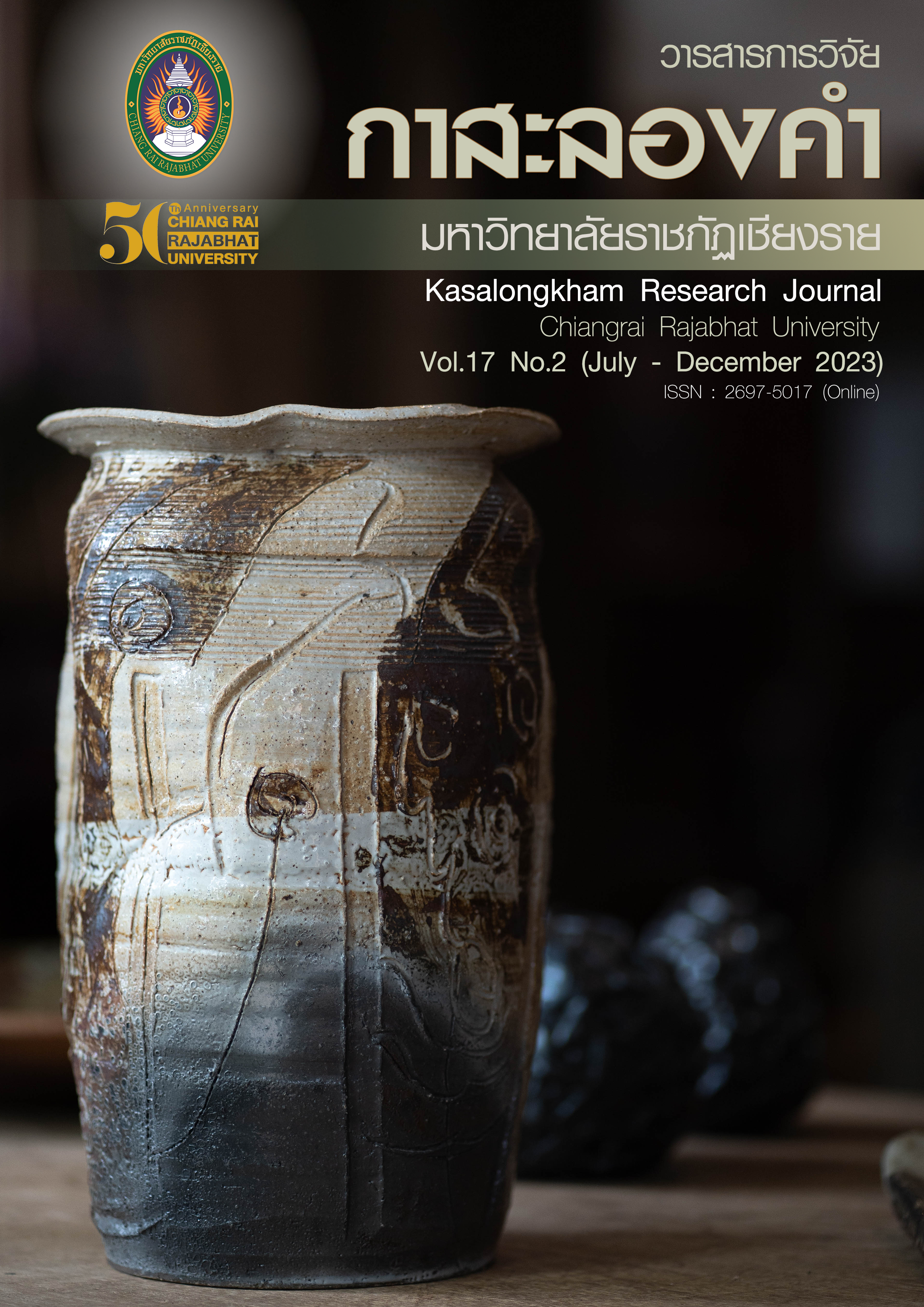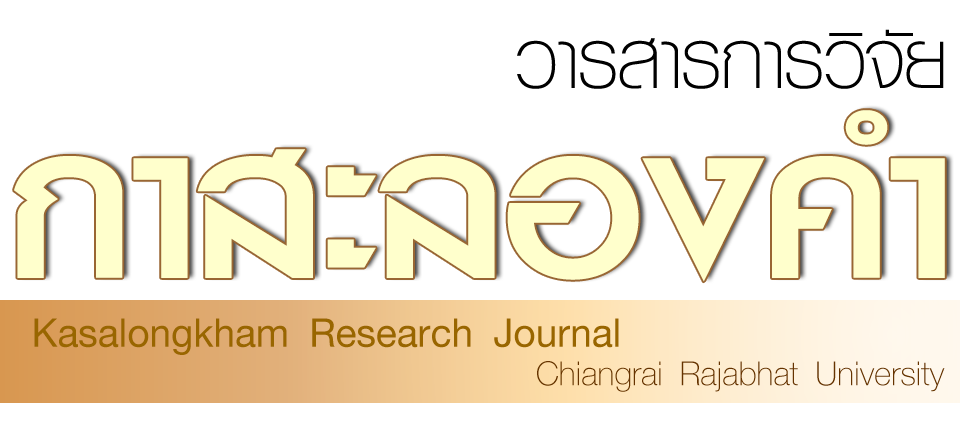ความสามารถในการให้เหตุผลทางคณิตศาสตร์ของนักศึกษาครูคณิตศาสตร์ ชั้นปีที่ 1: ผลจากการใช้รูปแบบการเรียนการสอนตามทฤษฎีสรรคนิยม
คำสำคัญ:
การศึกษาระดับความสามารถในการให้เหตุ, การให้เหตุผลทางคณิตศาสตร์, รูปแบบการเรียนการสอน, การสอนตามทฤษฎีสรรคนิยม, การสร้างความรู้ทางคณิตศาสตร์บทคัดย่อ
การวิจัยครั้งนี้มีวัตถุประสงค์เพื่อศึกษาผลของรูปแบบการเรียนการสอนตามทฤษฎีสรรคนิยมต่อความสามารถในการให้เหตุผลทางคณิตศาสตร์ของนักศึกษาชั้นปีที่ 1 สาขาคณิตศาสตร์ จากคณะครุศาสตร์ มหาวิทยาลัยราชภัฏเชียงราย ในภาคเรียนที่ 1 ปีการศึกษา 2565 จำนวน 26 คน ซึ่งมาจากการเลือกแบบเจาะจงด้วยเกณฑ์เป็นนักศึกษาที่ลงทะเบียนเรียนในรายวิชาหลักการทางคณิตศาสตร์หมู่เรียนที่ 2 เครื่องมือในการวิจัย ได้แก่ 1) รูปแบบการเรียนการสอนตามทฤษฎีสรรคนิยม 2) แบบวัดความสามารถในการให้เหตุผลทางคณิตศาสตร์ และ 3) แบบสัมภาษณ์แบบกึ่งโครงสร้างตรวจสอบความเข้าใจและการสร้างความรู้ทางคณิตศาสตร์จากการให้เหตุผลทางคณิตศาสตร์ การวิเคราะห์ข้อมูลเชิงปริมาณประกอบด้วยการหาค่าเฉลี่ย ส่วนเบี่ยงเบนมาตรฐาน และการทดสอบทางสถิติแบบนอนพาราเมตริก ส่วนการวิเคราะห์ข้อมูลเชิงคุณภาพเป็นการตีความเพื่อสร้างข้อสรุปแบบอุปนัย ผลการวิจัยพบว่า นักศึกษาที่เรียนด้วยรูปแบบการเรียนการสอนตามทฤษฎีสรรคนิยมมีความสามารถในการให้เหตุผลทางคณิตศาสตร์เพิ่มขึ้น ทั้งการให้เหตุผลแบบอุปนัยและการให้เหตุผลแบบนิรนัย โดยการทดสอบทางสถิติบ่งชี้ว่า การเปลี่ยนแปลงเหล่านี้มีนัยสำคัญที่ระดับ .05 (W = 0.000, z = 4.457, p < .001 สำหรับการให้เหตุผลแบบอุปนัย และ W = 0.000, z = 4.457, p < .001 สำหรับการให้เหตุผลแบบนิรนัย) ผลการสัมภาษณ์นักศึกษาที่เรียนด้วยรูปแบบการเรียนการสอนฯ สรุปได้ว่า นักศึกษาทุกคนสามารถบอกได้ว่าในการให้เหตุผลทางคณิตศาสตร์ประกอบไปด้วยการให้เหตุผลแบบอุปนัยและนิรนัยรวมถึงสามารถบอกคุณลักษณะการให้เหตุผลทั้ง 2 แบบได้อย่างถูกต้อง
เอกสารอ้างอิง
American Association for the Advancement of Science (AAAS). (1993). Benchmarks for Science Literacy. New York: Oxford University.
Artzt, A.F., & Shirel, Y.F. (1999). Mathematic reasoning during small-group problem solving. In developing mathematical reasoning in K – 12. Reston, Virginia: National Council of Teachers of Mathematics.
Buasonte, R. (2011). Mixed Methods in Educational Research. Silpakorn Educational Research Journal, 2(2), 7-20.
Buasonte, R. (2019). Research and Development of Educational Innovations. Bangkok: Chulalongkorn University Printing House.
Chinaphat, O. (2017). The Development of Learning Model Using the Constructivist to Develop the Mathematics Achievement of Students in Grade One. Ubon Ratchathani: Muangdet School.
Christiansen, C. (1969). Person-environment-occupation-performance: an occupation-based framework for practice. New Jersey: SLACK Incorporated.
Dewey, J. (1910). How We Think. Boston: D. C. Health & co., publishers.
Dossey, J. A. (1992). Mathematics methods and modeling for today’s mathematics classroom: A contemporary approach to teaching grades 7-12. CA: Brooks/Cole.
Ernest, D. (1993). Management: Theory and Practices. New York: McGraw-Hill Book Company.
Ernest, D. (1996). Personnel: Management People at Work. New York: The McMillan.
Felder, M. R. (1996) Matters of Style, ASEE Prism, 6(4): 18-23.
Jeannotte, L. (2015). Metonymy: hidden shortcuts in language, thought and communication. Cambridge: Cambridge University Press.
Kanari, Z. & Millar, R. (2004). Reasoning from data: How Students Collect and Interpret Data in Science Investigations, Journal of Research in Science Teaching, 41(7): 748-769.
Khaemmanee, T. (2007). INSTRUCTION MODEL: Various choices. Bangkok: Chulalongkorn University Printing House.
Khan, B. H. (2015). Web-based instruction. New Jersey: Educational Technologies Publication
Khunkaew, A. (2015). Measurement and Evaluation of New Education. Bangkok: Chulalongkorn University Printing House.
Lawson, A. E. (1995). Science Teaching and The Development of Thinking. Wadsword Publishing Company, Belmont, California.
Lerman, J. (1990). 101 best Web sites for teacher tools and professional development. Eugene: International Society for Technology in Education.
Mariotti, M. A. (2006). ‘Proof and proving in mathematics education’. In A. Gutiérrez & P. Boero (Eds.), Handbook of research on the psychology of mathematics education (pp. 173–203). Rotterdam: Sense.
Ministry of Education Thailand. (2017). Learning standards and indicators for learning subjects in mathematics, science, and geography in the group of learning social studies religion and culture (revised version 2017) according to the Basic Education Core Curriculum B.E. 2551. Bangkok: Ministry of Education.
Ministry of Education Thailand. (2019). Announcement of the Ministry of Education on Bachelor's Degree Qualifications in the Branch of Education (Four years program) B.E. 2562. 6 March 2019
Moore, D. S., McCabe, G. P., & Craig, B. A. (2012). Introduction to the practice of statistics (7th ed.). New York, NY: W. H. Freeman and Company.
National Council of Teachers of Mathematics, NCTM. (2000). Principle and Standards for School Mathematics. Virginia: National Council of Teacher of Mathematics.
Neubert, G. A., & Binko, J. B. (1992). Inductive reasoning in the secondary classroom. Washington DC: National Education Association.
Oehrtman, M. & Lawson, A. E. (2008). Connecting Science and Mathematics: The Nature of Proof and Disproof in Science and Mathematics. International Journal of Science and Mathematics Education, 6(2):377-403
Pedemonte B. (2001). Some cognitive aspects of the relationship between argumentation and proof in mathematics Proc. of the 25th Conference of the International Group for the Psychology of Mathematics Education PME-25, Editors: van den Heuvel- Panhuizen M., Utrecht (Olanda); vol. 4, 33-40
Phatthiyatanee, S. (2003). Educational Measurement (4th ed). Kalasin: Thaiprasan.
Polya, G. (1967). La decouverte des mathematiques. Paris: DUNOD.
Schoenfeld, A. H. (1983). Problem solving in the mathematics curriculum: A report, recommendations, and an annotated bibliography. The Mathematical Association of America, MAA Notes, No. 1.
Simon, M. A. & Deborah, S. (1993). Constructivism in Our Classroom. London: Rewood Books.
Stylianides, G. J. (2008). Proof and proving in school mathematics. Journal for Research in Mathematics Education, 38(1), 289-321.
Türkmen, H. (2006). How Should Science Be Taught by Using Learning Cycle Approach in Elementary Schools?. Elementary Education Online, 5(2): 1-15
Von Glasersfeld, E. (2001). Radical constructivism and teaching. Perspectives, 31(2), 191-204. Online available from: http://www.univie.ac.at/constructivism/EvG/papers/244.2.pdf
Yackel, E., & Hanna, G. (2003). ‘Reasoning and proof’. In J. Kilpatrick, W. G. Martin, & D. E. Schifter (Eds.), A research companion to principles and standards for school mathematics (pp. 227–236). Reston, Virginia: National Council of Teachers of Mathematics
Yumus, A. S. (2001). Levels of reasoning in mathematical concepts among preservice mathematics teachers. 2nd APED International Conference in Education Research Understanding Eduactional Issues in the Asia Pacific Region Universals, Uniqueness and Cooperation. Seoul, Korea, 52-61.

ดาวน์โหลด
เผยแพร่แล้ว
รูปแบบการอ้างอิง
ฉบับ
ประเภทบทความ
สัญญาอนุญาต
ลิขสิทธิ์ (c) 2023 วารสารการวิจัยกาสะลองคำ มหาวิทยาลัยราชภัฏเชียงราย

อนุญาตภายใต้เงื่อนไข Creative Commons Attribution-NonCommercial-NoDerivatives 4.0 International License.





